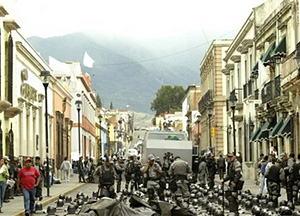 |
 |
 |
 News Around the Republic of Mexico | November 2006 News Around the Republic of Mexico | November 2006  
Protesters Overrun Oaxaca University
 Ioan Grillo - Associated Press Ioan Grillo - Associated Press


| | Mexican federal police stand guard in downtown Oaxaca, Mexico on Saturday, Nov. 4, 2006. Protests began in May with a strike by teachers demanding better pay and work conditions in one of Mexico's poorest states. When police violently broke up a demonstration in June, protesters expanded their demands to include Gov. Ulises Ruiz's resignation and were joined by leftists, Indian groups, students and others. (AP/Guillermo Arias) |
Masked men patrol the gates, armed with bats and gasoline bombs, and barbed wire and booby traps defile the campus lawns. Since protesters took over the state university in Mexico's besieged Oaxaca City, there have been no classes, only talk of revolution.

The university of 30,000 students has become a stronghold for leftists trying to oust the Oaxaca state governor in a five-month-old conflict that has left at least nine people dead.

Demonstrators poured into the university last weekend after thousands of federal police pushed them out of the city's main plaza, where they had camped out since May. Federal police tried but failed to clear street barricades outside the university Thursday; they are not allowed to enter the campus under a law designed to protect academic freedom.

University Rector Francisco Martinez has made it clear that police were not welcome.

"We cannot consent for the campus to be an object of occupation," he said in a radio message Friday. "I want to ask the federal government to be sensitive in its solution to the problem."

Some critics say the university's autonomy law is protecting rebellion.

Federal police backed by armored vehicles and helicopters surrounded the university Thursday. Hundreds of protesters ran out, attacking with gasoline bombs, stones and fireworks stuffed with glass and nails.

Police fought back with batons, water canons, tear gas and even threw back some rocks. After a six-hour battle that injured more than 30 people, police retreated and protesters claimed victory.

But they fear police could return at any moment.

"We are on maximum alert," said Guillermo Contreras, a teacher and protest supporter. "We will fight their weapons with our spirit and dignity."

Thousands of federal police now patrol Oaxaca's historic city center. Crowds of people flocked to welcome them when they first came in but less than a week later, some residents say they are intimidated by their presence.

"It's like we are living in a city under military occupation," said storeowner Bernard Cruz, opening up shop Saturday morning across the street from a group of 20 police with riot shields and rifles.

The protests began in May with a strike by teachers demanding better pay and work conditions in one of Mexico's poorest states. When police violently broke up a demonstration in June, protesters expanded their demands to include Gov. Ulises Ruiz's resignation and were joined by leftists, Indian groups, students and others.

The protesters accuse Ruiz of rigging the 2004 election and sending thugs to kill and intimidate his opponents.

On Friday, Mexico's largest leftist group, the Democratic Revolution Party, announced it would join the Oaxaca protesters in a demonstration Sunday, using its followers to form human chains around federal police detachments that enter the city.

Some say they feel safer inside the campus than on the street.

"I feel scared even in my home, because people know my family are part of the protests," said Cecilia Gomez, a 32-year-old school cleaner. "Here we have the strength of numbers."

Among those killed in the Oaxaca conflict was activist-journalist Bradley Roland Will, 36, of New York, who was shot in the stomach while filming a gunbattle on Oct. 27. The others have been mostly protesters shot by police or armed gangs.

Two officials of a municipality on the outskirts of Oaxaca City are in custody in connection with Will's killing, state officials have said.

On Friday, the press freedoms advocacy group Reporters Without Borders condemned "shortcomings" in the investigation into his death. The organization also said it had information that two Guatemalan journalists have gone missing in Oaxaca.

The conflict has shattered tourism in the city, which is popular for its colonial architecture and ancient ruins. A number of countries have advised citizens to avoid traveling to the region, including the United States, Canada, Britain, France and Germany. | 
 | |
 |



